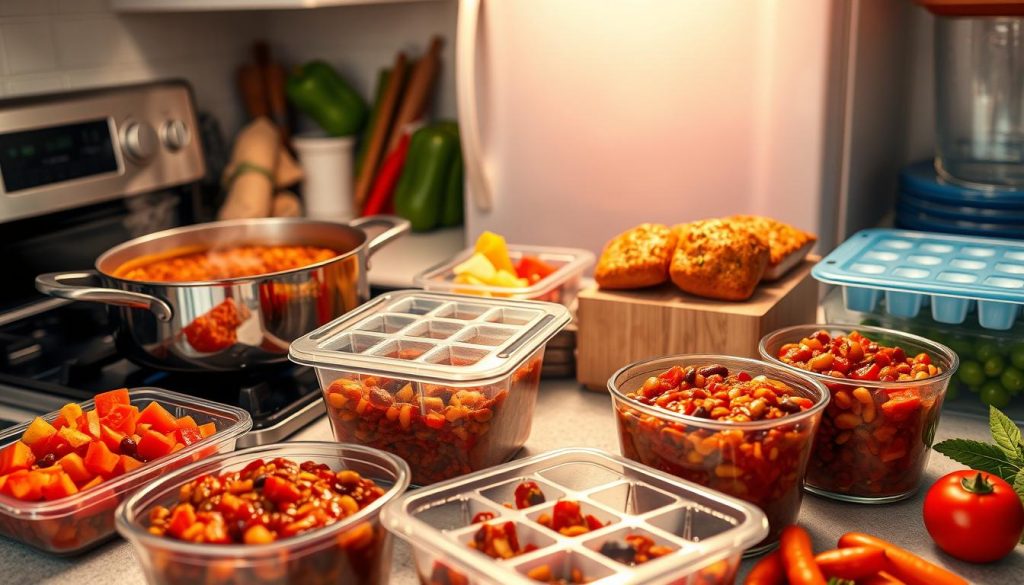Chili is a favorite comfort food that often leaves us with leftovers. We all want to enjoy our homemade chili for as long as possible. But, food safety is key. Let’s explore chili storage and refrigeration to keep our leftovers safe and tasty.
Proper chili storage is key for keeping its flavor and safety. Most chili recipes, whether meat-based or vegetarian, can last 3 to 4 days in the fridge. This applies to beef, pork, chicken, and turkey chili. Veggie and bean chilis might last up to 5 days, but it’s safer to be cautious.
For longer storage, freezing is best. Chili can stay good in the freezer for 4-6 months. When reheating, make sure it reaches 165°F for safe eating.
Key Takeaways
- Most chili varieties last 3-4 days in the fridge
- Vegetarian chili may last up to 5 days refrigerated
- Freeze chili for 4-6 months of quality storage
- Reheat chili to 165°F for food safety
- Use proper storage containers for best results
- Watch for signs of spoilage before consuming
Understanding Basic Food Safety for Chili Storage
To keep our chili safe, we must follow food safety rules. We’ll look at temperature control and stopping bacterial growth. This way, our chili stays tasty and safe to eat.
Safe Temperature Ranges for Chili Storage
The fridge should be at 40°F or colder for chili storage. This stops bacteria from growing and keeps our food safe. Using a fridge thermometer helps control the temperature.
The Importance of Proper Cooling
Cooling chili right is key to stop bacteria. It should cool from 135°F to 70°F in two hours. Then, it should get to 41°F or colder in four hours. This two-step cooling is critical for safety.
Critical Time-Temperature Guidelines
Knowing the “danger zone” is important to avoid food poisoning. Chili should not stay between 40°F and 140°F for over two hours. After cooking, chill it quickly to stay safe and fresh.
| Temperature Range | Time Limit | Action Required |
|---|---|---|
| Above 140°F | N/A | Safe temperature, can be held |
| 140°F to 70°F | 2 hours | Cool quickly to below 70°F |
| 70°F to 40°F | 4 hours | Refrigerate or use immediately |
| Below 40°F | 3-4 days | Safe for refrigerated storage |
By sticking to these food safety tips and keeping the right temperature, we can enjoy chili safely for up to four days in the fridge. Always be cautious and throw away any chili that looks or smells off.
How Long Does Chili Last in the Fridge
Knowing how long chili lasts in the fridge is key for safety and taste. We’ll look at how long different types of chili last. We’ll also see how ingredients affect storage time.
Storage Duration for Meat-Based Chili
Meat-based chili usually stays good for 3-4 days in the fridge. The U.S. Department of Agriculture (USDA) says leftovers, like chili, should be kept for no more than four days. It’s best to chill your chili within two hours of cooking.
Shelf Life of Vegetarian Chili
Vegetarian chili can last a bit longer. Without meat, it can stay fresh for up to 5 days. This is because vegetarian chili doesn’t have animal proteins, which spoil faster.
Impact of Ingredients on Storage Time
The ingredients in your chili greatly affect how long it stays fresh. Techniques for preserving ingredients can also play a role. Here’s a look at how different ingredients impact storage time:
| Ingredient | Impact on Storage Time |
|---|---|
| Ground Meat | Spoils faster, reduces shelf life |
| Whole Meat Cuts | Lasts longer than ground meat |
| Beans | Extends shelf life slightly |
| Cheese | Can extend shelf life to 4-5 days |
| Acidic Ingredients | Help preserve chili longer |
Keep in mind, these are general guidelines. Always check your chili’s freshness by using your senses and best judgment.
Proper Storage Containers and Methods
Choosing the right containers is essential for leftover chili. Airtight containers help keep your chili fresh and flavorful. They prevent moisture loss and flavor transfer, keeping your chili delicious for days.
Shallow containers are best for quick cooling, which is important for food safety. Let your chili cool to room temperature before storing it in the fridge. Never leave chili out for more than 2 hours to avoid bacterial growth.
To keep your chili fresh longer, follow these tips:
- Use containers sized 16-32 ounces for 1-2 servings
- Choose 32-48 ounce containers for 3-4 servings
- Opt for 64 ounces or larger for 5+ servings
- Label containers with the storage date
By following these guidelines, your chili can stay fresh in the fridge for 3-4 days. For longer storage, freeze your chili in freezer-safe bags or containers. This can extend its life up to 3-4 months.
| Storage Method | Container Type | Storage Duration |
|---|---|---|
| Refrigeration | Airtight container | 3-4 days |
| Refrigeration | Covered bowl | 2-3 days |
| Freezer | Freezer-safe container | 3-4 months |
Signs of Spoiled Chili to Watch For
It’s important to watch for signs of spoilage when it comes to chili. We’ll look at key signs to see if your chili is good to eat or if it’s time to throw it away.
Visual Indicators of Spoilage
The first sign of bad chili is often visible. Look for mold, which looks like fuzzy spots in different colors. If your chili has changed color a lot, it’s best to be safe.

Smell and Texture Changes
Trust your nose for chili freshness. A sour or bad smell means your chili has gone bad. The texture can also tell you a lot. If it feels slimy or has an odd feel, it’s time to get rid of it.
When to Discard Your Chili
If you see any of these signs, throw out your chili right away. Don’t taste it to check – even a little bit of bad food can make you sick. Chili usually lasts 3-4 days in the fridge. If you’re not sure if it’s fresh, it’s better to throw it away than risk getting sick.
| Spoilage Sign | Action |
|---|---|
| Mold or discoloration | Discard immediately |
| Sour or foul smell | Throw away without tasting |
| Slimy texture | Do not consume |
| Stored over 4 days | Consider discarding |
By watching for these signs, you can enjoy your chili safely. This way, you avoid health risks from bad food.
Best Practices for Cooling and Storing Fresh Chili
Preserving the flavor and safety of your homemade chili is key. We’ve got expert tips for you to master chili storage.
Quick Cooling Techniques
Rapid cooling is vital for food safety. An ice bath is a great method. Place your pot in a sink with ice water, stirring to cool evenly.
Another way is to use shallow containers. This helps heat escape faster.
Portioning for Storage
Good portion control is important. It makes reheating easier and cools faster. Divide your chili into smaller portions before refrigerating.
This way, you can thaw only what you need. It reduces waste and keeps quality high.
Airtight Container Selection
Choosing the right containers is key for freshness. Go for airtight, food-grade containers safe for fridge and freezer. Glass or BPA-free plastic is best.
| Container Type | Pros | Cons |
|---|---|---|
| Glass | Durable, non-reactive | Heavy, breakable |
| Plastic (BPA-free) | Lightweight, affordable | May stain or retain odors |
| Stainless Steel | Long-lasting, non-reactive | Can be expensive |
Follow these tips for cooling and storing chili. Enjoy your delicious creation safely for days. Remember, proper food handling is key for taste and health!
Freezing Chili for Extended Storage
Freezing chili is a smart way to keep it fresh for months. Chili can stay good in the freezer for 4 to 6 months. This makes it perfect for long-term storage and meal prep.

Before freezing, let your chili cool down completely. Then, put it in freezer-safe containers or bags. Souper cubes or freezer-safe bags work well for easy storage and thawing. Make sure to leave some space at the top, as chili expands when frozen.
Here are some tips for using your frozen chili:
- Label your containers with the date, serving size, and reheating instructions
- Consider doubling your chili recipe – eat half now and freeze the rest for later
- Freeze chili in individual portions for quick and easy meals
When you’re ready to thaw your chili, you have a few options. You can thaw it in the fridge overnight, use the cold water method for faster thawing, or defrost it in the microwave if you’re in a hurry. Frozen chili is a great solution for busy nights or when you want a hearty meal without cooking from scratch.
Safe Methods for Reheating Stored Chili
Chili often tastes better the next day. We’ll look at the best ways to reheat it safely and keep its flavor.
Microwave Reheating Guidelines
Microwaving is fast for reheating chili. Put chili in a safe container and heat in 30-second bursts, stirring each time. This method ensures chili heats evenly and avoids bacteria.
Stovetop Reheating Tips
For stovetop reheating, move chili to a pot and heat it on low. Stir often to avoid burning and add water if it gets too thick. This method gives you more control over the heat.
Safe Internal Temperature Requirements
Food safety is key, no matter how you reheat. Chili must reach 165°F (74°C) to be safe. Use a thermometer to check the temperature in different parts.
| Reheating Method | Time | Temperature | Tips |
|---|---|---|---|
| Microwave | 2-3 minutes | 165°F (74°C) | Stir every 30 seconds |
| Stovetop | 5-7 minutes | 165°F (74°C) | Stir frequently, add water if needed |
Reheating chili too many times can be risky. It’s safer to reheat only what you’ll eat. By following these tips, you’ll enjoy your chili safely and deliciously every time.
Different Types of Chili and Their Storage Times
We all love chili, and knowing how long to store it is important. It helps us enjoy our favorite dishes safely. Let’s look at how different types of chili and ingredients affect how long they last.
Meat-based chilies like beef and pork last 3-4 days in the fridge. Chicken and turkey chilies also last this long. Veggie chilies, like bean and vegetable, can stay fresh for 4-5 days. Cheese-based chilies can last up to 5 days in the fridge.
Canned chili is great for longer storage. It can last 4-6 months in the fridge and 3-5 years in your pantry. Once opened, use it within 7 days. Homemade chili can last 3-4 days in the fridge, or up to 7 days if it’s meatless. For longer storage, freeze it for 4-6 months at 0°F or below.
Chili peppers and spices have long shelf lives. Whole dried peppers and peppercorns can last up to 3-4 years. Ground peppers and chili powders last 2-4 years. Fresh peppers can last 2-3 weeks in the fridge, with thicker-walled ones lasting longer.




